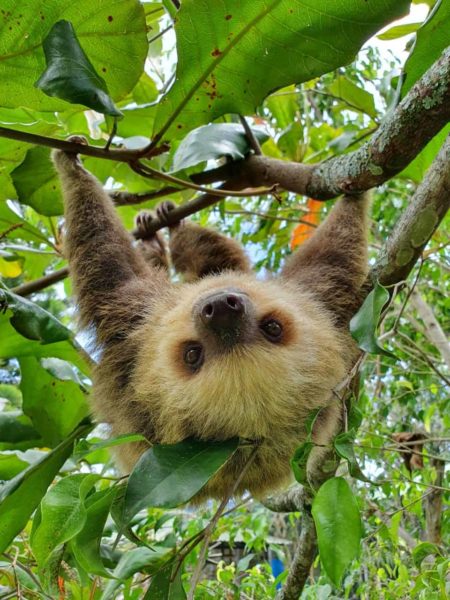Looks can be deceiving, as those of us who work with sloths can tell you. This is especially true with Hoffman’s Two-Fingered sloths, the lesser-known of the two types of Costa Rican sloths.
While most people think of sloths as mellow and slow, this is not the case with the two-fingered sloths. They are quite aggressive and quick, which makes them challenging to work with when they are brought to our rescue facility, the Toucan Rescue Ranch in San Isidro de Heredia.
This applies to not only injured adults but orphaned and injured babies as well. Because of their solitary nature, they are not accustomed to being around humans and are not afraid to express their feelings about their new — in most cases temporary — situation, and it can be quite daunting!
Last month, we received an injured, particularly fuzzy two-fingered juvenile sloth from Cartago, who had been found caught in barbed wire.
The person who found her called the Environment Ministry (MINAE), and they brought her to us. They named her Osa, the Spanish word for bear, due to her very thick fur and chubby appearance. Hoffman’s two-fingered sloths are found all over Costa Rica, and those who live at higher elevations, like Osa, look like an almost completely different animal compared to their counterparts from lower elevations, which have thinner coats.

When babies are found alone, an effort is made to search the trees for any females, with the hope that the mother may be nearby and they can be reunited. In the cases where there are no adult sloths in the immediate area, the baby must be removed, as it is very vulnerable at that point and may be injured or too young to survive on its own.
When Osa arrived at our facility, she had some deep cuts and was severely dehydrated. Despite her compromised health, she has proven to be a great patient. From the onset, she willingly drank Pedialyte to replenish her electrolytes, then transitioned to drinking goat’s milk with a syringe and small nipple.

Young sloths are taken outside to go potty daily, and she happily complies when placed at the base of a small palm tree. During the day, she is allowed to climb around in a large Beach Almond tree with Oatmeal, another of our young sloth patients. It’s wonderful to watch them happily sun themselves, and feast on leaves all day.
Osa devours the cooked green beans and carrots given to all of our sloths, and she loves the scrambled egg offered twice a week. These and the fresh Poro leaves offered daily have helped her gain weight.
Her wounds have healed, and she has passed the 2-kilo mark, which is the point in development where juvenile sloths can survive on their own.
She is an independent aggressive little sloth who threatens to bite anyone who comes near her, so that is a very good sign.
Due to all of these factors, it’s been determined that she can be released in the upcoming weeks. The MINAE officer who picked her up in Cartago will be returning her to the area where she was found, and she can continue her brand of social distancing — something that sloths have been doing for thousands of years.
When that day arrives, we’ll wish her a safe journey, knowing that we were able to give her that second chance to live a long healthy, wildlife. We all love a happy ending… or beginning.
— Denise Gillen is an Animal Support Volunteer at Toucan Rescue Ranch.

This article was produced by The Toucan Rescue Ranch. The Toucan Rescue Ranch specializes in helping wild animals recover so that they can be reintroduced into the wild. For more information or to donate, visit the Toucan Rescue Ranch website.






